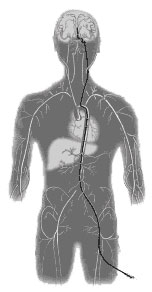Coil Embolization
Endovascular therapy is a minimally invasive way to diagnose and treat a patient from within a blood vessel. In the case of a brain aneurysm, this treatment is called coil embolization, or "coiling."
Coiling does not require open surgery. Instead, physicians use real-time X-ray technology, called fluoroscopic imaging, to visualize the patient's vascular system and treat the disease from inside the blood vessel.
Minimally Invasive
 Coil Embolization
Coiling involves insertion of a catheter into the femoral artery in the patient's leg and navigating the catheter through the vascular system into the patient's head and to the aneurysm. The entire process is done using continual X-ray visualization and high-speed radiographic filming techniques.
Coil Embolization
Coiling involves insertion of a catheter into the femoral artery in the patient's leg and navigating the catheter through the vascular system into the patient's head and to the aneurysm. The entire process is done using continual X-ray visualization and high-speed radiographic filming techniques.
Once the physician has detected the presence, size, and location of the aneurysm, a smaller "microcatheter" is then placed inside the initial catheter. When the microcatheter has been successfully navigated into the aneurysm opening, the coiling system is introduced.
Platinum coils are deposited into the aneurysm, reducing or blocking the flow of blood to the aneurysm. The coils are made of platinum so they are visible via X-ray and are flexible enough to conform to the aneurysm's shape. The goal of coiling is to pack the aneurysm tightly to close off the flow of blood to the aneurysm, thereby preventing its rupture.
Once placed inside the aneurysm, a small electrical current is passed through the wire. As a result of this electrolysis, the coil detaches from the wire and remains inside the aneurysm.
After the aneurysm has been packed, the catheters are removed and the patient is transferred to Intensive Care for monitoring and further care.
Coiling procedures are performed under general anesthesia.
After the Procedure
Patients who have the coiling procedure done before an aneurysm ruptures can expect to spend the night in Intensive Care for monitoring. Typically, they do not experience pain or scarring as a result of the coiling procedure.
Patients with a ruptured aneurysm have a longer stay in Intensive Care, typically 10 to 14 days.
When Time is Critical, Experience Matters
When a patient is diagnosed with a brain aneurysm, time is critical. There is a 50 percent chance of mortality and morbidity after the first rupture of an aneurysm; that number increases to 75 percent after a second rupture.
When your patient is in need of treatment, the OSF St. Joseph Medical Center team is immediately available with the experience and expertise you expect.
Better Patient Outcomes
Studies comparing endovascular coiling and surgical treatment of unruptured aneurysms have found that endovascular coiling is associated with shorter hospital stays and shorter recovery times.
In addition, research has shown that for patients equally suited for both open surgery and coiling, endovascular coiling treatment produces substantially better patient outcomes than surgery in terms of survival free of disability at one year.
The relative risk of death or significant disability one year after a patient is treated with coils was 22.6 percent lower than in surgically-treated patients*.
Contact Information
For more information about coiling services, please call (309) 665-4780.
